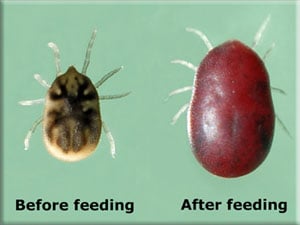Transmission

O. hermsi tick, before and after feeding. Photo taken by Gary Hettrick RML, NIAID.
Borrelia bacteria that cause TBRF are transmitted to humans through the bite of infected “soft ticks” of the genus Ornithodoros. Soft ticks differ in two important ways from the more familiar “hard ticks” (e.g., the dog tick and the deer tick). First, the bite of soft ticks is brief, usually lasting less than half an hour. Second, soft ticks do not search for prey in tall grass or brush. Instead, they live within rodent burrows, feeding as needed on the rodent as it sleeps.
Humans typically come into contact with soft ticks when they sleep in rodent-infested cabins. The ticks emerge at night and feed briefly while the person is sleeping. The bites are painless, and most people are unaware that they have been bitten. Between meals, the ticks may return to the nesting materials in their host burrows.
There are several Borrelia species that cause TBRF, and these are usually associated with specific species of ticks. For instance, B. hermsii is transmitted by O. hermsi ticks, B. parkeri by O. parkeri ticks, and B. turicatae by O. turicata ticks. Each tick species has a preferred habitat and preferred set of hosts:
- Ornithodoros hermsi tends to be found at higher altitudes (1500 to 8000 feet) where it is associated primarily with ground or tree squirrels and chipmunks.
- Ornithodoros parkeri occurs at lower altitudes, where they inhabit caves and the burrows of ground squirrels and prairie dogs, as well as those of burrowing owls.
- Ornithodoros turicata occurs in caves and ground squirrel or prairie dog burrows in the plains regions of the Southwest, feeding off these animals and occasionally burrowing owls or other burrow- or cave-dwelling animals.
Soft ticks can live up to 10 years; in certain parts of the Russia the same tick has been found to live almost 20 years. Individual ticks will take many blood meals during each stage of their life cycle, and some species can pass the infection along through their eggs to their offspring. The long life span of soft ticks means that once a cabin or homestead is infested, it may remain infested unless steps are taken to find and remove the rodent nest.